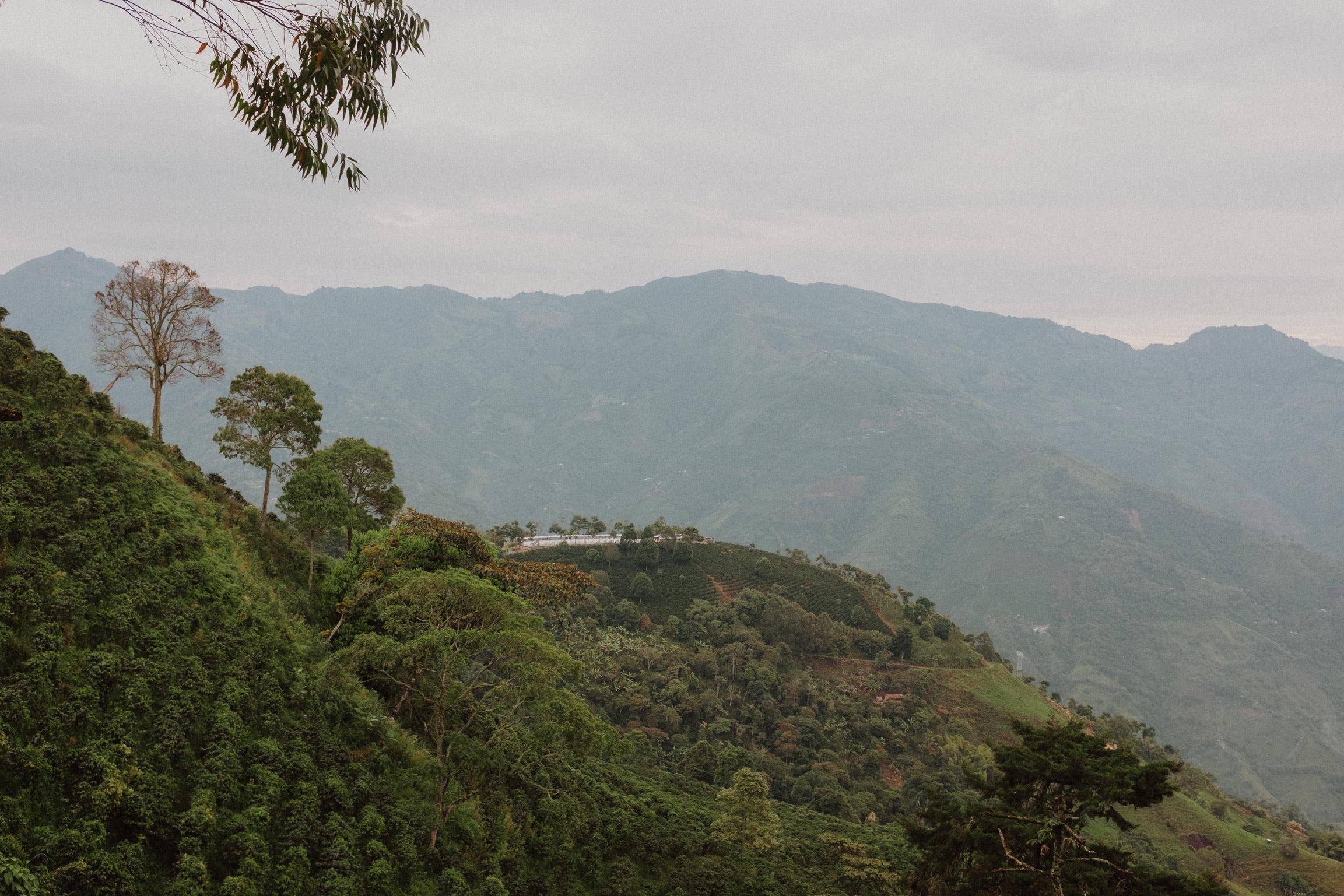
Species of trees
As with wines, the species and variety of a tree are fundamental to the quality of the final product. Although there are many families of coffee species, 99% of the world’s coffee comes from just two: Arabica and Canephora (also known as Robusta). In general, Arabica species produce higher quality coffees, while Canephora is more productive and resistant to pests and diseases.
The Arabica species is mainly cultivated in Central America, Colombia, Peru, Brazil and some countries in East Africa. Robusta is mainly produced in Brazil, Vietnam, Indonesia and a handful of African countries. The latter, given its low price and poor quality, is widely used in instant coffees around the world. As we are a company specializing in high quality coffees, we will concentrate for the moment only on the Coffea Arabica species — the only species cultivated in Colombia. Within the Arabica species, there are many different varieties (somewhat similar to the different canine breeds). A significant number of these have been identified and cataloged, while others exist only in the wild — mainly in Ethiopia, the birthplace of coffee. Each variety is defined by a distinct phenotype.
The phenotype describes the structure and size of a tree as well as its branches, the shape of its leaves, the color of its cherries, the shape of it beans, and most importantly — the final cup profile produced by its fruit. The most important varieties within the Arabica species fall into two categories: pure and hybrid. Pure varieties have not been genetically modified, and have evolved over time through natural mutations. Genetically-mixed varieties are produced by crossing different varieties of pure Arabica with the Timor Hybrid, a cross between Canephora and Arabica. The final result is a plant with a cup quality similar to pure Arabicas, but with the partial resistance to diseases and pests of a Canephora.
In the world of specialty coffees, we prefer the pure varieties — although a select few hybrids score highly enough to be classified as specialty.
-
TYPICA
Tipo: Pure
History: Typica owes its name to the fact that it was the first variety to leave Ethiopia more than 400 years ago. Passing through Yemen to Indonesia, the Typica plant arrived in the Americas via European colonizers, who spread it from the island of Martinique throughout Central and South America. Typica can be thought of as the origin of the majority of Arabica varieties in Latin America. During the second half of the 19th century and the first half of the 20th century, it dominated coffee production in Colombia. Today it can be difficult to come by. Due to its high susceptibility to coffee rust, the once-dominant Typica variety has been replaced by more resistant varieties. In Antioquia and the coffee region, it is called Pajarito, while in the south of the country, the variety is called Común (Common).
Phenotype: Characterized by long internodes and a tall stature, the tree’s fruits are always red and susceptible to rust, and its branches grow at an open angle (67o). Its beans are elongated and larger than other varieties.
-
BORBÓN
Type: Pure. Spontaneous mutation of Typica..
History: Borbón comes from a natural mutation of Typica, which developed in the Borbón Islands (now called the Reunion Islands) off the east coast of Africa. Nowadays, it is quite common in Guatemala, El Salvador and Brazil. Despite enjoying some popularity in Colombia around the mid-20th century, today it is quite difficult to find. Like Typica, it is highly susceptible to coffee rust.
Phenotype: With branches angled at 58o, narrower than the Typica, it has green buds, red or yellow fruits, and small beans. A highly productive variety, Borbón has replaced Typica as one of the most common varieties cultivated throughout Central America, the Caribbean, and Brazil. And for good reason — it’s famous for its high quality cups.
-
GESHA
Type: Pure.
Historia: Originally from the region of Gesha in Ethiopia, this variety was collected and studied by scientists, who brought it to a research center in Costa Rica in the mid-20th century. Finding it to produce quality cups with very particular sensorial characteristics, coffee farmers brought it to Panama for commercial cultivation.
Phenotype: Gesha is a medium-sized tree, with average productivity and a special requirement for shade. It produces a cup with very intense and particular aromatic qualities, reminiscent of flowers and citrus fruits. Many people find it to be more aromatic than tea. Coffees of this variety are among the most exclusive and expensive in the world.
-
CATURRA
Tipo: Pure. Borbón mutation.
History: The Caturra variety originated from a spontaneous mutation of the Borbón tree, observed for the first time in the Brazilian state of Minas Gerais. Known for its short trees, Caturra first arrived in Colombia in 1952, and began to spread more widely throughout the country in the 1970s. Today, it is quite hard to come across, but can be found in southern Colombia. Unfortunately, it is also highly susceptible to rust.
Phenotype: A short, compact, and highly-productive tree, the Caturra variety has light green leaves, green buds, red or yellow fruit, and medium-sized beans. It thrives in colder climates.
-
VARIETY COLOMBIA
Type: Hybrid (Cross between Borbón, Caturra, Typica and Hybrid of Timor).
History: On September 27, 1983, coffee rust was identified for the first time in Colombia in the municipality of Chinchiná, Caldas. In attempt to produce a tree that was resistant to the pest, while retaining the desirable attributes of Arabica, the Cenicafé Coffee Research Center began crossing different varieties and species. Landing upon a cross of Hybrid of Timor with Borbón, Caturra, and Typica, researchers launched the Colombia variety in 1984. It spread rapidly throughout the country thanks to government recovery programs underway at the time.
Phenotype: The Colombia variety is a short tree, similar in appearance to Caturra, but with greater resistance to coffee rust.
-
CASTILLO
Tipo: Hybrid. Cross between Borbón, Caturra, Typica and Hybrid of Timor. The difference between the Colombia variety and Castillo is that the latter has greater genetic variability and more of Hybrid of Timor’s resistance to rust.
History: The Castillo variety was created by Cenicafé in 2005, and has been promoted by the National Coffee Growers Federation, given its productivity and resistance to coffee rust. However, its cup quality is the subject of heated debate, since many believe it will never produce as high-quality beans as a pure variety.
Phentype: Similar to the Colombia variety – a smaller tree, with green buds and short internodes.
Seguir Leyendo
-

01. Introduction
See moreWe are privileged to work in every stage of the coffee process — from farm to cup.
-

02. What are specialty coffees?
See moreWe’ll begin by defining specialty coffees — and what differentiates them from lower-quality beans.
-

03. Describing coffee
See moreCoffee is like wine. There’s the gas-station kind that taste like sludge, the critically-acclaimed kind that experts and hipsters alike hail as tasting like bouquets of flowers — and everything in between.
-

04. Agronomy
See moreThe process begins with a seed (the coffee bean itself) planted in sand, where it germinates into a small seedling called a “chapola.” After 3 months, the seedling is transplanted into a small bag, and continues to grow until it is strong enough to be planted in the field.
-

05. Farm processing
See moreRemember that the coffee we consume is the roasted seed of a fruit. The fruit begins its process of transformation when it is picked from the tree. Unlike other fruits (such as banana, avocado, mango, etc.), coffee can’t be picked while it is still green. It must be harvested at the perfect point of ripeness, when the cherry has fully matured.
-

06. Roasting
See moreAt Pergamino, we are artisanal roasters. is means several things. First, that we roast in small batches under the careful oversight of a master roaster. We analyze each batch of green coffee in depth in order to determine the ideal roasting curve for its density, profile and final destination.
-

07. Species of trees
See moreAt Pergamino, we are artisanal roasters. is means several things. First, that we roast in small batches under the careful oversight of a master roaster. We analyze each batch of green coffee in depth in order to determine the ideal roasting curve for its density, profile and final destination.
-

08. Extraction theory
See moreAs you can see, behind each cup of coffee is a world of complexity — meaning that we have a huge responsibility at the moment of the final brew. At Pergamino, we are very proud of our team of baristas, who assume this responsibility with great professionalism. They receive constant training, not only in the preparation of our drinks, but in the entire backstory of our coffees, and how to pass on their unique stories to our customers. But do not worry — with a little discipline and curiosity, you, too, can learn to make excellent coffee at home!
-

09. Preparation of filtered coffee
See moreBefore going into detail about brewing, we’d like to cover the core principles of coffee extraction. Brewing coffee is always a delicate game — balancing the quantity of coffee, the quantity of water, the type of grind, and the extraction time. Depending on the method, these factors can be varied in order to highlight specific attributes of a coffee.
-

10. History
See moreCoffee’s global voyage began in the lush highlands of Ethiopia, the original motherland of the Coffea Arabica plant. The earliest known writing on the coffee plant, dating to the 10th century, characterizes it as a medicine—prepared as an infusion of coffee cherries in hot water.
-

11. The Allied Farmers Project
See moreLike all small, medium and large producers in Colombia, Pergamino spent many years helplessly riding the roller coaster of international coffee prices. We had to invest in our crops without knowing what they would sell for during their 12-year production cycle.
-

12. Dreams of the future
See moreWe dare to share with you a dream that we have for the future. Colombian coffee has changed a lot in the last 80 years, shifting towards more technical, large-scale cultivation — with widespread use of chemical fertilizers, pesticides, monoculture, and complete exposure (without shade trees).
-

13. Brewing methods
See moreThese are our favorite methods and advices
-

Navidad (500g bag)
Allied producers across Colombia
Regular price $18.99Regular priceUnit price / per -

Special Edition, Gesha Convite (360g bag)
Inzá, Cauca
Regular price $26.99Regular priceUnit price / per -

Three-Origin Kit (500g bag) - 10% off
Allied producers across Colombia
Regular price $49.47Regular priceUnit price / per -

Lomaverde (500g bag)
Santa Bárbara, Antioquia
Regular price $16.99Regular priceUnit price / per




















